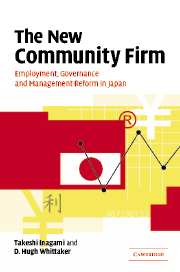Book contents
- Frontmatter
- Contents
- List of figures
- List of tables
- Preface
- Acknowledgements
- Part 1 The End of the Community Firm?
- 1 Company as Community
- 2 The Classic Model: Benchmark for Change
- 3 Change and Continuity
- 4 Company Professionals and Creative Work
- 5 Corporate Governance and Managers' Ideologies
- 6 Consolidated Management and Quasi Internal Labour Markets
- 7 Summing Up
- Part 2 Hitachi: ‘Here, the Future’
- Part 3 The Reformed Model
- Appendix: Changes in Job Tenure
- References
- Index
1 - Company as Community
Published online by Cambridge University Press: 22 September 2009
- Frontmatter
- Contents
- List of figures
- List of tables
- Preface
- Acknowledgements
- Part 1 The End of the Community Firm?
- 1 Company as Community
- 2 The Classic Model: Benchmark for Change
- 3 Change and Continuity
- 4 Company Professionals and Creative Work
- 5 Corporate Governance and Managers' Ideologies
- 6 Consolidated Management and Quasi Internal Labour Markets
- 7 Summing Up
- Part 2 Hitachi: ‘Here, the Future’
- Part 3 The Reformed Model
- Appendix: Changes in Job Tenure
- References
- Index
Summary
Entering a minefield
In writing about companies-as-communities, or ‘community firms’ in Japan, we are entering a minefield. The term eludes neat definition, and easy quantification. And for some people, it evokes negative reactions. The Japanese equivalent – kigyo kyodotai – can conjure up images of oppressive wartime control and ‘feudal’ communitarian institutions. For some, it epitomizes Japan's ‘corporate-centred society’ and its associated patriarchal order. Community companies are male-dominated, discriminate against women, encroach on and distort family life (Osawa, 1993; Kumazawa, 2000). Collectively, they have created Japan's ‘corporate capitalism’, which perverts fundamental capitalist and market principles, breeds corruption and impedes healthy social development (Okumura, 1975, 1984, 1992). For others, they served a purpose during Japan's catch-up phase of development, but those days are over. Without a process of creative destruction, which includes ‘Japanese-style management’ and community firms, Japan will flounder in the twenty-first century (Tsujimura, 1998). Some of these criticisms, in fact, now find expression in official government publications, and the Japanese government itself has become one of the biggest critics.
On the other hand, community companies have their defenders, including the heads of some of Japan's most successful corporations, although they may not use the expression directly. Canon's president, for instance, declared:
The advantage of lifetime employment is that employees absorb the company's culture throughout their careers. As a result, team spirit grows among them – a willingness to protect the corporate brand and stick together to pull through crises. I believe that such an employment practice conforms to Japanese culture and is our core competency to survive global competition.
- Type
- Chapter
- Information
- The New Community FirmEmployment, Governance and Management Reform in Japan, pp. 3 - 18Publisher: Cambridge University PressPrint publication year: 2005



